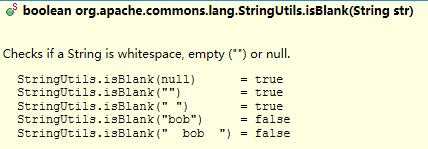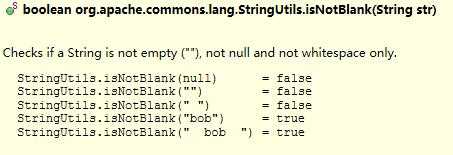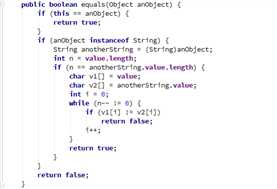标签:
上一篇介绍了 String 中的几个常用构造方法,由 String 这个核心对象发散出去关于字符的编码,字符的字节表达,对 GC 的影响,正则表达式,模式匹配,这可能是 Java 里内涵最丰富的对象了。今天先讲一下 API 中定义的一些常用方法。
1、length 方法
length()
Returns the length of the sequence of characters represented by this object.
返回字符串的长度(或者理解为对应字符数组的长度),如果字符串对象的值为 null 则抛出空指针异常(java.lang.NullPointerException)。
String str = "你好,谷歌!"; String str1 = "Hello, google!"; System.out.println(str.length()); System.out.println(str1.length());
运行结果为:
6 14
2、isEmpty 方法
public boolean isEmpty()
Returns true if length() is 0, otherwise false.
如果字符串的长度为 0,则返回 true, 否则返回 false。
如果字符串对象的值为 null 则抛出空指针异常(java.lang.NullPointerException)。
注意:因为在使用过程中,会忘记字符串值为 null 的情况,所有判断字符串为空尽量使用 org.apache.commons.lang.StringUtils 中封装的几个方法:
1)isEmpty 方法

源码如下:
public static boolean isEmpty(String str) { return str == null || str.length() == 0; }
2)isNotEmpty 方法

源码如下:
public static boolean isNotEmpty(String str) { return !StringUtils.isEmpty(str); }
3)isBlank 方法

源码如下:
public static boolean isBlank(String str) { int strLen; if (str == null || (strLen = str.length()) == 0) { return true; } for (int i = 0; i < strLen; i++) { if ((Character.isWhitespace(str.charAt(i)) == false)) { return false; } } return true; }
4)isNotBlank 方法

源码如下:
public static boolean isNotBlank(String str) { return !StringUtils.isBlank(str); }
3、charAt 方法
charAt(int index)
Returns the char value at the specified index. An index ranges from 0 to length() - 1. The first char value of the sequence is at index 0, the next at index 1, and so on, as for array indexing.
Throws:
IndexOutOfBoundsException - if the index argument is negative or not less than the length of this string.
返回索引位置的字符(String 本身就是 char[] 数组类型)
参数为 int index,范围为从 0 到 length() -1
如果索引是负数或者大于或等于字符串的长度,则会抛出索引越界异常 IndexOutOfBoundsException。
String str = "hello, google!"; System.out.println(str.charAt(0)); System.out.println(str.charAt(str.length() - 1));
运行结果:
h
!
4、getByte 方法
getBytes()
Encodes this String into a sequence of bytes using the platform‘s default charset, storing the result into a new byte array.
getBytes(Charset charset)
Encodes this String into a sequence of bytes using the given charset, storing the result into a new byte array.
两个方法均返回字符串对应的(指定编码方式的)字节类型数组。
return new String(str.getBytes("iso-8859-1"), "UTF-8");
5、equals 方法
equals(Object anObject)
Compares this string to the specified object.
比较两个对象是否内容相等,话不多说,直接上经典的源码实现:

通常将常量放在前面,变量放在后边
String str = "hello, google"; if ("hello, baidu".equals(str)) { System.out.println("Are you kidding me?"); } else { System.out.println("It‘s OK!"); }
输出结果:
It‘s OK!
6、compareTo 方法
compareTo(String anotherString)
Compares two strings lexicographically.
按照字典顺序比较两个字符串,相等返回 0,在 anotherString 前面返回小于 0 的值,否则返回大于 0 的值。
String str = "hello, google";
System.out.println("compare with baidu: " + str.compareTo("hello, baidu"));
输出结果:
compare with baidu: 5
该方法应用于 Java 中的比较器的实现(内部和外部两种),有关知识参阅:Java_两种比较器的实现。
PS:外部比较器可以用匿名内部类实现较为简单,或者用 java8 中的 lambda 表达式更是简单,有关 lambda 知识参阅:Java8 初体验(一)lambda 表达式语法
7、startsWith 方法 和 endsWith 方法
startsWith(String prefix)
Tests if this string starts with the specified prefix.
startsWith(String prefix, int toffset)
Tests if the substring of this string beginning at the specified index starts with the specified prefix.
endsWith(String suffix)
Tests if this string ends with the specified suffix.
判断字符串是否已给定的字符串开头或者结尾(这里的参数只能是字符串,不支持正则表达式)
String str = "hello, google";
System.out.println(str.startsWith("google", 7));
输出结果:
true
8、hashCode 方法
Returns a hash code for this string.
返回该字符串的哈希值,在初始化对象时,如果该对象可能进行比较,则需要根据要比较的属性重写 equals() 和 hashCode() 方法。
9、indexOf 方法 和 lastIndexOf 方法
indexOf(int ch)
Returns the index within this string of the first occurrence of the specified character.
indexOf(int ch, int fromIndex)
Returns the index within this string of the first occurrence of the specified character, starting the search at the specified index.
indexOf(String str)
Returns the index within this string of the first occurrence of the specified substring.
indexOf(String str, int fromIndex)
Returns the index within this string of the first occurrence of the specified substring, starting at the specified index.
lastIndexOf(int ch)
Returns the index within this string of the last occurrence of the specified character.
lastIndexOf(int ch, int fromIndex)
Returns the index within this string of the last occurrence of the specified character, searching backward starting at the specified index.
lastIndexOf(String str)
Returns the index within this string of the last occurrence of the specified substring.
lastIndexOf(String str, int fromIndex)
Returns the index within this string of the last occurrence of the specified substring, searching backward starting at the specified index.
返回的均是索引值(int),还是看图直观:

String str = "hello, google"; System.out.println("the second g‘s index is: " + str.indexOf(103, 8)); System.out.println("google‘s index is: " + str.indexOf("google"));
输出结果:
g‘s index is: 10 google‘s index is: 7
10、substring 方法
substring(int beginIndex)
Returns a string that is a substring of this string.
substring(int beginIndex, int endIndex)
Returns a string that is a substring of this string.
这个方法估计用到的频率最高了,分隔字符串方法,会抛出索引越界异常。

String str = "hello, google";
System.out.println(str.substring(0, 5));
输出结果:
hello
记住一点就好:前闭后开 [beginIndex, endIndex)
感谢 bing 搜索:https://cn.bing.com/
标签:
原文地址:http://www.cnblogs.com/JavaSubin/p/5468452.html